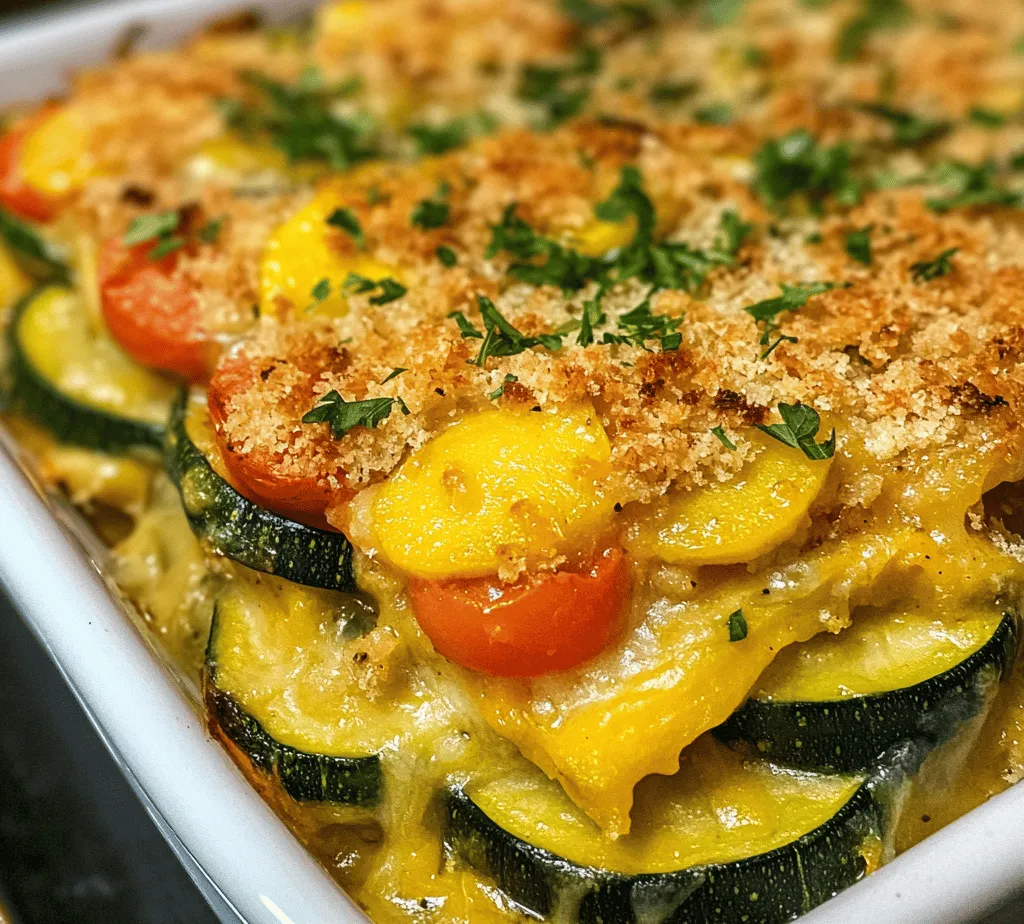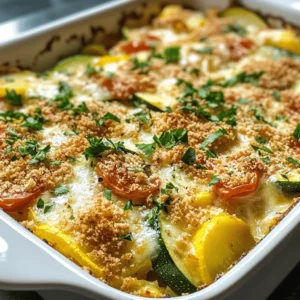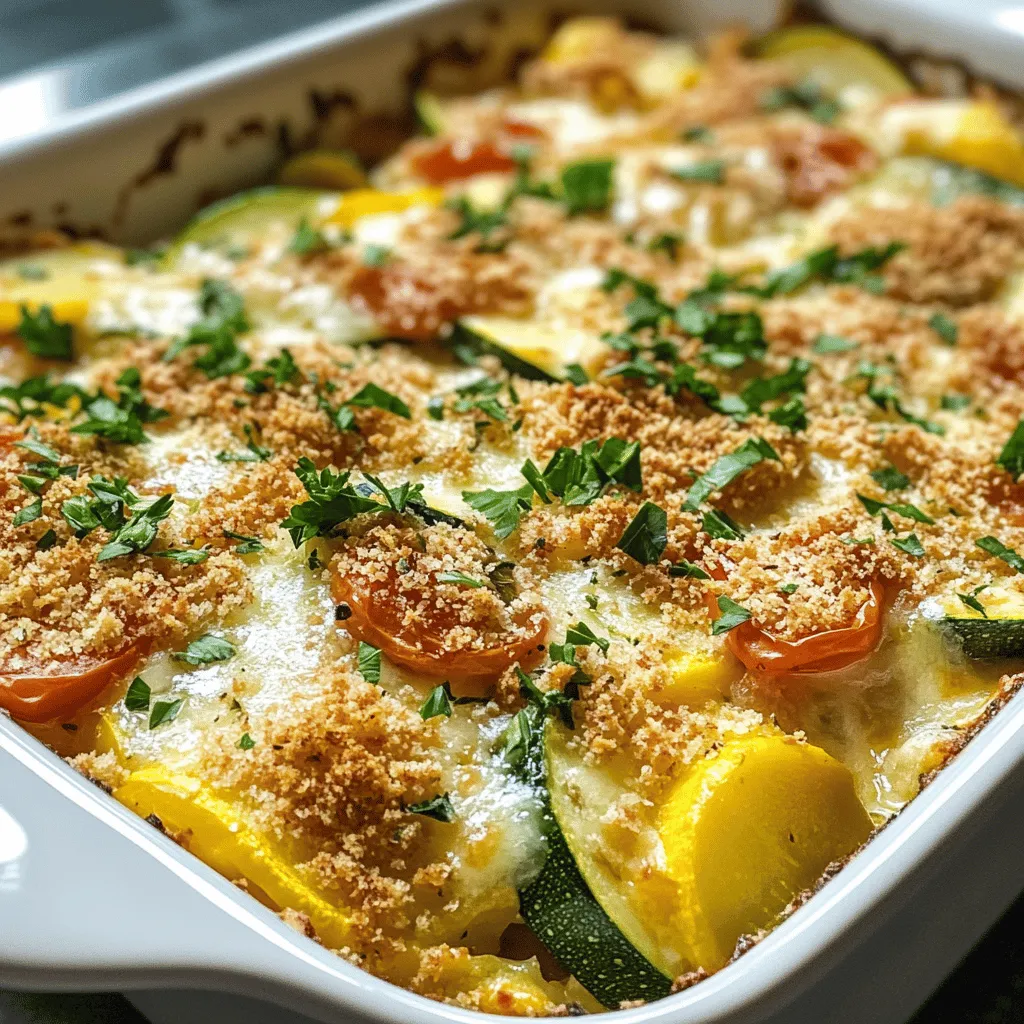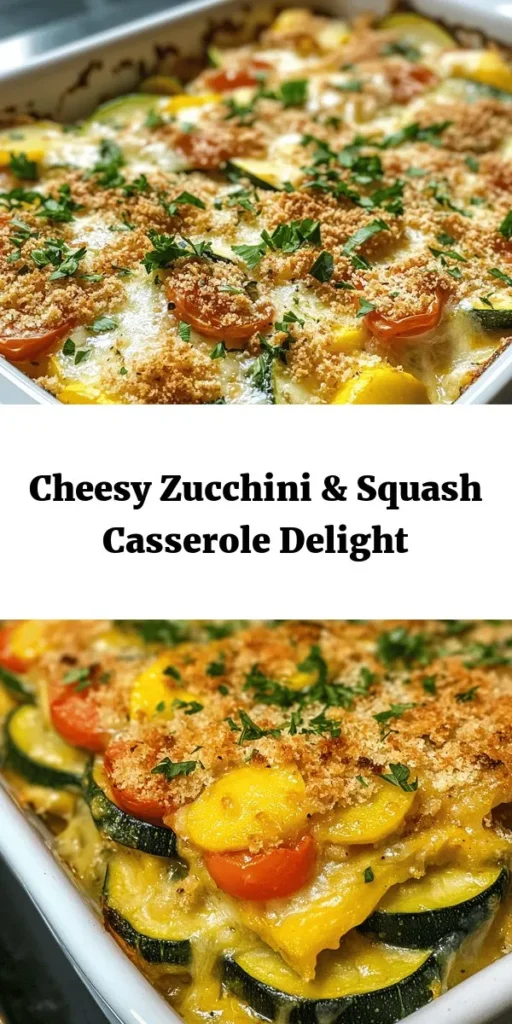Introduction
When it comes to hearty yet healthy meals, few dishes can compete with a vibrant zucchini and squash casserole. This delightful recipe not only showcases the natural flavors of these two vegetables but also offers a satisfying way to incorporate more plant-based goodness into your diet. Whether you’re a seasoned chef or a home cook looking to try something new, this casserole is a versatile and nourishing option that can be enjoyed any night of the week.
One of the key appeals of this dish is its ability to transform simple ingredients into a comforting meal that is both filling and nutritious. By layering zucchini and yellow squash with creamy cheese, fresh herbs, and a crunchy topping, you create a symphony of flavors and textures that will please even the pickiest eaters. Beyond its delicious taste, this casserole serves as an excellent reminder of the importance of incorporating vegetables into our daily meals, making it easier to meet our nutritional needs while enjoying every bite.
Zucchini and squash are not only versatile in the kitchen but also packed with nutrients. They provide essential vitamins and minerals, making this casserole a perfect choice for those looking to boost their vegetable intake without compromising on flavor. Plus, with the right balance of ingredients, this dish can easily adapt to dietary preferences and restrictions, whether you’re aiming for a gluten-free option or wanting to add more protein.
The Allure of Zucchini and Squash
Nutritional Profile of Zucchini and Yellow Squash
Zucchini and yellow squash are both members of the summer squash family, well-known for their light, refreshing flavors and numerous health benefits. Zucchini is low in calories yet high in essential nutrients, making it an excellent choice for those watching their caloric intake. A single cup of sliced zucchini contains approximately 19 calories, along with a modest amount of vitamin C, potassium, and fiber. This combination not only supports hydration but also promotes digestive health, helping you feel full longer.
Yellow squash, on the other hand, boasts a slightly sweeter flavor that complements zucchini beautifully. It contains similar nutritional benefits, including vitamin A, which is crucial for eye health, and folate, which supports cellular function and tissue growth. Together, these two squashes create a nutritious powerhouse, providing a variety of vitamins and minerals that contribute to overall well-being.
Health Benefits of These Vegetables
Incorporating zucchini and yellow squash into your meals can have several health benefits. These vegetables are rich in antioxidants, which help combat oxidative stress in the body. They also provide a good source of dietary fiber, aiding in digestion and promoting heart health. Furthermore, the hydration that zucchini offers, thanks to its high water content, can help maintain skin health and support bodily functions.
Adding these vegetables to your diet can also assist in weight management, as their low-calorie count allows for generous servings without the guilt. The combination of fiber and water in zucchini and squash helps keep you feeling satisfied, making it a smart choice for those looking to maintain a balanced diet.
Seasonal Availability and Sustainability Aspects
Zucchini and yellow squash are typically in season during the warmer months, from late spring through early fall. This seasonal availability means that you can often find these vegetables fresh at local farmer’s markets or grocery stores, supporting local agriculture and reducing your carbon footprint. Buying in-season produce not only guarantees better flavor and nutrition but also aligns with sustainable eating practices, allowing you to enjoy vegetables at their peak freshness.
By embracing seasonal cooking with zucchini and squash, you can create meals that are not only delicious but also environmentally conscious. Using locally sourced ingredients not only benefits your health but also supports local farmers and reduces the environmental impact associated with long-distance transportation.
Ingredients Breakdown
Creating a standout zucchini and squash casserole requires a thoughtful selection of ingredients, each contributing unique flavors and textures to the final dish.
Zucchini: Texture and Flavor Profile
Zucchini is renowned for its mild flavor and tender texture, which allows it to absorb the flavors of accompanying ingredients beautifully. When cooked, it becomes soft and slightly sweet, providing a wonderful base for the casserole. Its versatility allows it to shine in both savory and sweet dishes, but in this casserole, it takes center stage with its subtle nuttiness that enriches the overall flavor profile.
Yellow Squash: How It Complements Zucchini
Yellow squash is slightly sweeter than zucchini, adding a delightful contrast to the dish. Its firm texture ensures that it holds up during baking, creating a satisfying bite alongside the softer zucchini. The combination of these two squashes not only enhances the visual appeal of the casserole with their vibrant colors but also adds depth to the flavor, making each forkful a delightful experience.
Onions and Garlic: Their Role in Flavor Enhancement
No casserole is complete without the aromatic duo of onions and garlic. Sautéing these ingredients before adding them to the casserole releases their natural sweetness and depth of flavor, creating a fragrant base that elevates the dish. Onions provide a savory undertone, while garlic adds a hint of pungency that balances the sweetness of the squashes. Together, they work harmoniously to enhance the overall flavor profile of the casserole.
Cherry Tomatoes: Adding Sweetness and Color
Adding cherry tomatoes brings a burst of color and sweetness to the casserole. When roasted, these small tomatoes caramelize, intensifying their flavor and adding a juicy texture that contrasts beautifully with the creamy elements of the dish. Their bright red hue also enhances the visual appeal, making the casserole not only delicious but also a feast for the eyes.
Cheddar Cheese: Creaminess and Depth of Flavor
Cheddar cheese is a classic choice for casseroles, providing a rich and creamy element that binds the dish together. Its sharpness adds complexity to the flavor, making each bite indulgent. As the cheese melts, it forms a gooey layer that complements the tender vegetables, creating a comforting and satisfying experience. For an extra twist, you can experiment with different cheese varieties to suit your taste.
Heavy Cream: Providing Richness
Heavy cream is the secret ingredient that adds a luscious richness to the casserole. It creates a creamy sauce that envelops the vegetables, ensuring that every bite is decadent. The creaminess also balances the acidity of the tomatoes and the sharpness of the cheese, resulting in a harmonious blend of flavors that will leave you craving more.
Breadcrumbs: For Texture and Crunch
To achieve that perfect contrast in texture, a layer of breadcrumbs is essential. They provide a delightful crunch that enhances the overall eating experience. When baked, the breadcrumbs turn golden and crispy, creating a satisfying topping that contrasts beautifully with the creamy filling below. You can use plain, seasoned, or even gluten-free breadcrumbs to accommodate different dietary needs.
Herbs and Spices: Oregano and Basil’s Contributions
Fresh herbs are key to brightening up the casserole and adding layers of flavor. Oregano and basil are classic choices that complement the vegetables perfectly. Oregano brings an earthy, slightly peppery flavor, while basil adds a touch of sweetness and freshness. Together, they elevate the dish, making it aromatic and inviting.
Olive Oil: Health Benefits and Cooking Properties
Olive oil is an essential ingredient in this recipe, serving multiple purposes. Not only does it provide a healthy source of fat that enhances flavor, but it also aids in the cooking process. Sautéing vegetables in olive oil helps to retain their nutrients while adding a delicious richness. Furthermore, olive oil is known for its heart-healthy properties, making it a smart choice for your cooking needs.
Fresh Parsley: Finishing Touch for Presentation
Finally, a sprinkle of fresh parsley adds a pop of color and freshness to the dish. This vibrant herb not only enhances the presentation but also contributes a mild, grassy flavor that balances the richness of the casserole. When served, the parsley provides a visually appealing contrast to the warm, golden topping, making the dish look as good as it tastes.
Step-by-Step Cooking Instructions
Prepping the Ingredients
Before diving into the cooking process, it’s essential to prepare all your ingredients. Start by washing the zucchini and yellow squash thoroughly to remove any dirt or residue. Next, trim off the ends and slice them into uniform rounds or half-moons, depending on your preference. Aim for pieces that are about ¼ inch thick to ensure even cooking. This slicing technique allows the vegetables to cook uniformly, contributing to a well-balanced texture in the finished casserole.
When it comes to the onions and garlic, finely chop the onion and mince the garlic. These aromatics will be sautéed together, creating a fragrant base for the casserole. Ensure that your cherry tomatoes are halved or quartered, depending on their size, to enhance their sweetness during roasting. Lastly, grate the cheddar cheese and measure out your heavy cream, breadcrumbs, and herbs to streamline the cooking process.
Tips on Slicing and Dicing for Optimal Cooking
To achieve optimal cooking results, pay attention to the size and shape of your vegetable cuts. Slicing the zucchini and squash into even rounds ensures that they cook uniformly, preventing some pieces from becoming mushy while others remain crunchy. Using a sharp knife and a cutting board will make the task easier and safer.
If you prefer a more rustic look for your casserole, you can also use a mandoline slicer for perfectly uniform cuts. Just be cautious while using it, as mandolines can be quite sharp. Remember to keep your cuts consistent, as this will help the vegetables cook evenly and provide a more aesthetically pleasing presentation.
Sautéing the Vegetables
With your ingredients prepped, it’s time to sauté the vegetables. Heat a generous splash of olive oil in a large skillet over medium heat. Once hot, add the chopped onions and garlic, stirring frequently until they become translucent and fragrant, about 3-5 minutes. This step is crucial, as it develops the foundational flavors of the casserole.
Next, add the sliced zucchini and yellow squash to the skillet, seasoning them with salt, pepper, and a sprinkle of oregano. Sauté the vegetables for about 5-7 minutes, stirring occasionally, until they begin to soften but still retain some bite. This technique not only enhances the flavors but also allows excess moisture to escape, preventing a watery casserole.
Once the vegetables are sautéed to your liking, add the halved cherry tomatoes and continue to cook for an additional 2-3 minutes. This final addition allows the tomatoes to soften slightly, releasing their juices and sweetness, which will meld beautifully with the other ingredients in the casserole.
As you sauté, keep in mind that the goal is to develop a balance of flavors while retaining the vegetables’ texture. The sautéing process enhances the dish by intensifying the flavors, ensuring that each ingredient shines in the final casserole.
—
This overview of the Zesty Zucchini & Squash Casserole sets the stage for a delightful culinary adventure, celebrating the fresh flavors of summer squash while providing a nutritious and satisfying meal option. Stay tuned for the next part, where we will delve into the assembly and baking process, ensuring you achieve the perfect casserole every time.

Assembling the Casserole
Once you have prepared your ingredients, it’s time to assemble the Zesty Zucchini & Squash Casserole. Begin by preheating your oven to 375°F (190°C). This ensures that your casserole will cook evenly once it’s placed in the oven.
Start by greasing a 9×13-inch baking dish with olive oil or cooking spray to prevent sticking. This will also add a subtle flavor to the dish. Next, begin layering your vegetables. Start with a layer of sliced zucchini, followed by a layer of yellow squash. Sprinkle a bit of salt and pepper over these layers to season them lightly.
Continue layering: add a layer of diced bell peppers and onions, followed by a sprinkle of your chosen cheese. Repeat this process until all ingredients are used, finishing with a layer of cheese on top. This layering technique not only allows for even cooking but also helps infuse flavors throughout the casserole as it bakes.
Baking the Casserole
Once your casserole is fully assembled, it’s time to bake it. Cover the baking dish with aluminum foil—this will help trap steam, keeping your vegetables tender as they cook. Place the casserole in the preheated oven and bake for 25 minutes.
After 25 minutes, remove the foil and return the casserole to the oven for an additional 15-20 minutes. This uncovered baking time is crucial for achieving that golden, bubbly cheese topping we all love. Keep an eye on the casserole during the last few minutes to prevent the cheese from burning.
Cooling and Serving
After baking, it’s important to let the casserole cool for about 10-15 minutes before serving. This resting period allows the layers to set and makes it easier to slice. If you serve it right away, you might find that it falls apart on your plate, compromising the beautiful presentation.
To serve, cut the casserole into generous squares, making sure to include a bit of each layer on the plate. The vibrant colors of the zucchini, squash, and cheese will create an inviting presentation that is sure to impress your guests.
Flavor Variations and Customization
One of the best aspects of the Zesty Zucchini & Squash Casserole is its versatility. Here are a few suggestions for customization:
– Ingredient Substitutions: If you have veggies in your fridge that you need to use up, feel free to experiment! Broccoli, spinach, or even diced tomatoes can be great additions. For a heartier dish, consider adding cooked quinoa or rice between the layers.
– Different Cheeses: While cheddar cheese is a popular choice, you can mix it up with mozzarella for a gooey texture, feta for a tangy kick, or even a sprinkle of Parmesan for a nutty flavor.
– Adding Proteins: For those looking to add some protein, cooked ground turkey or shredded chicken can be layered in. For a vegetarian protein boost, try adding chickpeas or lentils.
– Adjusting Seasoning: If you enjoy a bit of heat, consider adding red pepper flakes, or for a more robust flavor, a dash of smoked paprika or garlic powder can elevate the dish.
– Making it Gluten-Free or Dairy-Free: To cater to gluten-free diets, ensure that your breadcrumbs are gluten-free or substitute with crushed nuts for a crunchy topping. For a dairy-free version, use plant-based cheeses or simply omit cheese altogether and enhance the flavors with more herbs and spices.
Nutritional Information
This Zesty Zucchini & Squash Casserole is not only delicious but also a nutritious choice for meals. A typical serving (1/8 of the casserole) contains approximately:
– Calories: 220
– Total Fats: 12g
– Proteins: 10g
– Carbohydrates: 20g
This makes it a balanced meal option, rich in vitamins and minerals from the fresh vegetables. The casserole fits well into various dietary lifestyles, including vegetarian and low-carb options, especially when you adjust the ingredient ratios accordingly.
Eating a variety of vegetables like zucchini and squash provides essential nutrients such as vitamin C, potassium, and fiber which promote good health and aid in digestion.
Serving Suggestions
This casserole is incredibly versatile when it comes to meal pairing. Here are some serving suggestions to enhance your dining experience:
– Mains: Serve it alongside grilled chicken or fish for a complete meal. The casserole’s flavors pair beautifully with lemon-herb grilled chicken or a simple baked salmon.
– Sides: Complement it with a fresh garden salad or some crusty whole-grain bread. The lightness of the salad contrasts nicely with the hearty casserole.
– Occasions: This dish is perfect for family dinners, potlucks, and even holiday gatherings. It can serve a crowd and is sure to be a hit with both kids and adults alike.
– Presentation: To make your casserole visually appealing, consider garnishing it with fresh herbs like parsley or basil before serving. This adds a pop of color and freshness to the dish.
Storing and Reheating Tips
Leftovers can be stored conveniently in the refrigerator. Here are some best practices for storing and reheating your casserole:
– Storing: Allow the casserole to cool completely before transferring it to an airtight container. It can be stored in the refrigerator for up to 4 days.
– Reheating: When you’re ready to enjoy leftovers, reheat individual portions in the microwave for 2-3 minutes, or place the entire casserole back in the oven at 350°F (175°C) for about 20 minutes until heated through.
– Freezing Options: If you want to prepare meals in advance, this casserole freezes well. Wrap it tightly in plastic wrap and aluminum foil, or use a freezer-safe container. It can be frozen for up to 3 months. To reheat, thaw overnight in the refrigerator and bake as mentioned above.
Conclusion
The Zesty Zucchini & Squash Casserole is a delightful dish that brings together the fresh flavors of summer vegetables in a hearty and satisfying meal. With its versatility, nutritional benefits, and ease of preparation, this casserole is perfect for any occasion.
This recipe not only showcases the joy of cooking with fresh ingredients but also encourages creativity in the kitchen. So, whether you’re hosting a family dinner or simply looking for a healthy weeknight meal, give this casserole a try. Enjoy the process, savor the flavors, and most importantly, have fun cooking!



